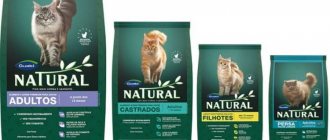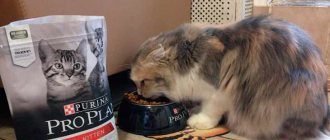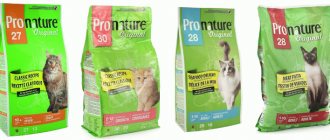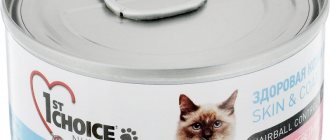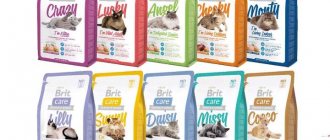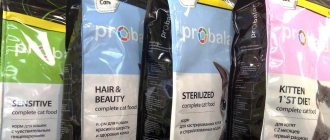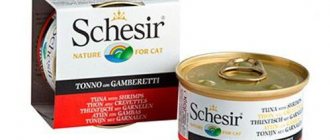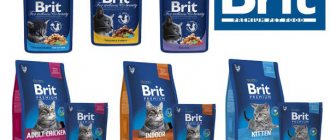general information
Officially, Eukanuba food belongs to the super-premium class. The products were of high quality when they were produced by the Procter and Gamble corporation. In the summer of 2014, the company sold the brand to Mars. Since then, the recipe began to deteriorate, they began to include increasingly cheaper ingredients and reduced the proportion of meat. Despite the assurances of the manufacturers, in fact the food belongs to the premium class.
There are several versions of the logo, but this is the most common and is present on most Eukanuba food packaging.
Initially, the Eukanuba formula was just an offshoot of the main Yams brand. Paul Yams, the company's founder, wanted to give the food a different name to highlight the updated recipe.
The release of such products reduces trust in the manufacturer
Mars Corporation has a controversial reputation among pet owners. It produces budget foods: Whiskas, Kitiket, Sheba, Perfect Fit, Royal Canin, etc. Additionally, there is a wide range of dog diets.
Advantages and disadvantages
The advantages of eukanuba include:
- animal meat is in 1st place in the composition;
- the presence of useful additives: flax seed, brewer's yeast, etc.;
- the price corresponds to the quality (middle price segment).
And now the disadvantages:
- a lot of low-quality carbohydrates in the composition (corn, wheat);
- other controversial ingredients (animal fat, sodium chloride);
- overall a bit poor lineup.
Conclusion: eukanuba food is 3+. Not the best, but not the worst either. It is not a fact that an active dog will have enough nutrients.
Types of feed "Eukanuba"
The corporation produces 6 types of dry food and 6 types of wet diets. There are products for kittens, adult and senior cats. There are no therapeutic diets, but there are preventative ones: for overweight animals, for hair removal, etc.
Kitten food
The company produces wet and dry food for kittens.
Wet food
Wet food is recommended to be used as an intermediate link when switching from mother's milk to dry ready-made diets. Dense pellets with low moisture levels can cause digestive upset in animals. In some cases, gastrointestinal pathologies even develop due to a sharp restructuring of the body. Many kittens refuse pellets and prefer soft food. To switch to adult diets, animals are first offered wet food, then soaked in dry food, and only then given the latter in its original form.
Wet food for kittens contains the following ingredients:
- meat and offal (including chicken at least 26%);
- cereals;
- vitamins and minerals;
- amino acid methionine;
- fish fat.
The manufacturer states that this is a complete food, i.e. it can be given to a cat throughout its life without additional additives. It already contains the necessary vitamins, microelements and other useful substances. Unfortunately, the manufacturer achieves balance through individual additives rather than whole components, but this is a standard situation for wet food.
It is advisable to introduce wet food into the diet from 4–6 weeks
The company highlights the following advantages of the formula:
- Optimal protein content for healthy growth and development of internal organs.
- Support the immune system with antioxidants.
- Ability to control urine pH levels.
- Improved coat and skin health with fish oil.
- Strengthening the muscle corset with animal proteins.
- Improved digestion due to plant fibers and the presence of prebiotics in the composition.
In fact, the manufacturer names many imaginary advantages. For example, protein in the feed is only 7.6%. This is not very much, especially considering that the composition includes cereals as a cheap filler. I do not recommend using Eukanuba wet food instead of complete food: I am familiar with more than one case where a kitten, having matured, was then unable to eat pelleted foods and suffered from gastrointestinal diseases. Often, in animals that eat only jellies and sauces, inflammation of the paraanal glands is detected. They are cleaned naturally during bowel movements, but when eating soft food, minced meat and puree, the feces become too soft and do not cause excess secretion to be released. As a result, the glands become clogged, inflamed and enlarged. Symptoms can only be eliminated through manual cleansing. Often, even after normalization of pets’ diet, relapses occur.
Dry food
Dry food for kittens is high in fish oil. It contains unsaturated fatty acids, which are necessary for the proper functioning of the brain and nervous system, strengthening the immune system, improving the condition of the skin and coat, etc.
The composition of dry food "Eukanuba" includes the following components:
- animal proteins (43% – poultry, a natural source of taurine);
- animal fat;
- barley;
- wheat;
- Wheat flour;
- rice;
- dry whole egg;
- hydrolyzed animal protein;
- sugar beet pulp;
- fish fat;
- fructooligosaccharides;
- dried brewer's yeast;
- minerals.
The benefits declared by the manufacturer are the same. Additionally, the company emphasizes that dry food helps maintain dental health by mechanically cleaning the surface. In reality this is not the case. Dry food itself not only does not clean the teeth completely, but also provokes the appearance of plaque stones. My first cat started having problems with her mouth when she was 3-4 years old. Then I thought that Eukanuba and Royal Canin foods were the best, so I gave them to her. First my gums became inflamed, then I noticed tartar. I had to go to the vet. The specialist explained to me that only special medicinal foods with a porous texture are suitable for prevention. They really clean the entire surface, because when pressed they fall inward. A regular product does not have this effect: the granules simply break apart. Pieces of food clean only the ends, pushing the plaque closer to the roots. As a result, it accumulates and turns into solid deposits.
The manufacturer suggests giving dry food to kittens per month, but even if the granules are pre-soaked, it is advisable not to immediately switch the animal to a mono-diet
The composition of dry food is slightly better than wet food, but still clearly does not reach the super-premium class. In the first place is not meat, but animal proteins - an ingredient of dubious quality. “Bird” is also not a specific component. These designations can mean either duck or turkey, or chicken or other dubious sources of protein. Judging by the names of the ingredients, the production does not use pure meat, but a mixture of claws, beaks, feathers, etc. If the corporation had nothing to hide, they would indicate the type of component: dehydrated meat, fresh fillet, or at least flour.
The manufacturer does not indicate calorie content, but the fat content of the feed is quite high - 24%. The company suggests giving the product to pregnant and lactating cats. Due to the high fat content, it can be dangerous for unhealthy animals, so it is advisable to seek veterinary advice first. The share of proteins is 36%. This is a good indicator, but given the predominance of cereals, the advantage is doubtful.
Food for adult cats
The company produces several varieties of dry and wet food for adult cats.
Wet food
There are 4 types of wet food. The main difference lies in the main ingredient and taste of the product. Since the composition of different types of food is approximately the same, we will consider only one sample.
Formally, the food actually contains rabbit, but its share is minimal
The wet ready-made rabbit diet contains the following ingredients:
- meat and offal (including rabbit at least 4%);
- cereals;
- vitamins and minerals;
- amino acid methionine;
- fish fat.
4% meat is very little. The mark “including” indirectly indicates that other varieties are also used in production. Considering that chicken feed contains more of the main ingredient (24%), rabbit is not the main component, but a flavoring additive. This looks like a dubious marketing ploy. As in the case of its analogue for kittens, it is better not to use wet food for systematic feeding.
Dry food
The company produces 3 types of dry food. In this case, they differ not in flavor additives, but in specialization. One food is universal, the rest can be used for prevention. Let's take a look at each ready-made diet to understand whether the manufacturer keeps its promises regarding improving the health of animals.
Universal chicken food is suitable for animals without special needs, as it contains a standard amount of nutrients: proteins, fats, vitamins, etc.
Universal chicken feed contains the following components:
- animal proteins (poultry 41%, natural source of taurine);
- rice;
- animal fat;
- wheat;
- vegetable fibers;
- hydrolyzed animal protein;
- sugar beet pulp;
- dry whole egg;
- fructooligosaccharides;
- minerals;
- dried brewer's yeast;
- fish fat.
The food is not suitable for cats that are prone to allergic reactions due to the presence of wheat in the composition. It often causes intolerance. Beet pulp is a good supplement that improves digestion, but given the high grain content, it seems superfluous: the product already has enough fiber. The whole egg is the only quality source of animal protein, but its share is too small. The only meat component is animal proteins. It's a low quality ingredient that could actually be anything. The proportion of fish oil is very small, so it is present here, rather, to balance the balance or as a marketing ploy.
The food for sterilized cats and overweight animals includes the following components:
- animal proteins (poultry 35%, natural source of taurine);
- wheat;
- barley;
- Wheat flour;
- animal fat;
- rice;
- dry whole egg;
- hydrolyzed animal protein;
- sugar beet pulp;
- minerals;
- dried brewer's yeast;
- fructooligosaccharides;
- fish fat.
Food for sterilized animals must meet 2 main requirements: low calorie content and the prevention of urolithiasis. It is impossible to check whether a product meets the first criterion due to a lack of information: the manufacturer does not indicate the nutritional value of ready-made diets. This can already be considered a significant disadvantage, since buyers can only take their word for it. With the prevention of urolithiasis, the situation is even worse. The composition not only does not contain a single therapeutic ingredient, but also has an increased concentration of phosphorus and calcium. This was found out during research by Roskachestvo: the actual amount of microelements differs from that indicated by the manufacturer. This provokes the formation of stones. I personally know of 2 cases where cats developed urolithiasis after eating Eukanuba food. Then I didn’t know what it was connected with, and I thought it was just a coincidence. When I encountered negative reviews, I became convinced that these were not isolated episodes.
In fact, the food is absolutely not suitable for sterilized animals: many buyers complain that it contains salt, although the manufacturer hides this
If we compare food for sterilized cats with a standard ready-made diet, the former is much inferior. The proportion of meat in it is even lower (35% versus 41%). There are more grains, with wheat in second place and divided into 2 separate ingredients: wheat flour and wheat. Probably, if not for this marketing ploy, the beans would have taken first place. This is a powerful allergen, so its presence in feed is not recommended. Even budget rice is better, because it is less likely to cause negative reactions from the immune system. If the animal develops an allergy, owners of sterilized cats will not be able to find an analogue.
The food for removing hairballs from the gastrointestinal tract includes the following components:
- animal proteins (poultry 43%, natural source of taurine);
- animal fat;
- wheat;
- vegetable fibers;
- sugar beet pulp;
- rice;
- Wheat flour;
- dry whole egg;
- hydrolyzed animal protein;
- minerals;
- fructooligosaccharides;
- dried brewer's yeast;
- fish fat.
In general, the food is able to cope with its task: the composition includes vegetable fibers and beet pulp. Plant fibers capture hairs and remove them from the gastrointestinal tract before the hair clumps and clogs the intestines. However, the prepared diet contains few nutrients, which in itself can provoke increased hair loss.
The manufacturer decided to fight not the cause, but the consequences: it is necessary not only to remove hair from the stomach, but also to prevent its excessive loss with the help of a high concentration of animal proteins and fish oil
Despite the presence of therapeutic additives (albeit not the highest quality), I cannot recommend this food. A friend of mine has 2 long-haired Scottish cats at home. They used to shed a lot. This not only created aesthetic inconvenience, but also harmed the health of the animals. Cats have been observed vomiting hairballs. It turned out that the animals eat the preventative food “Eukanuba”. I advised them to switch to Orijen products. At first, my friend was hesitant because of the relatively high price, but then she finally decided. After 2 months, attacks of vomiting began to bother the cats less frequently. A year later the problem was forgotten.
Food for older cats
There are 2 types of food for older cats: dry and wet. The line contains only 2 products.
Wet food
The presence of wet food in the series for older cats is in itself commendable, since many animals lose part of their teeth by the age of 10–12 years. Oral diseases can make it difficult for pets to chew hard, dry kibble. Sometimes this causes a refusal to eat or even the appearance of wounds and their further infection.
Wet food with such a poor composition is a dubious decision, because it is necessary to intensively maintain the health of depleted internal organs
The wet food contains the following ingredients:
- meat and offal (including chicken at least 26%);
- cereals;
- vitamins and minerals;
- amino acid methionine;
- fish fat.
The composition completely coincides with the list of ingredients of food for kittens and partially with the list of components of similar diets for adult cats. Even the amount of added vitamins is the same. The obvious difference lies only in the ratio of BZHU: proteins in food for older cats are 8.5%, and fats are 4%. This is more than in a ready-made diet for kittens, but the difference is not fundamental. The manufacturer claims that the food supports heart health. Most likely, this is provided by fish oil, which is also present in other similar products.
Dry food
In theory, dry food for older cats should be enriched with therapeutic additives to maintain the health of the urinary system, musculoskeletal system and heart muscle. Cranberries can act as an oxidizing agent. To obtain glucosamine and chondroitin, cartilage, shellfish extract, crab shells, etc. are used. A high concentration of animal proteins is encouraged. Pets absorb plant compounds less well, and amino acids are required to maintain muscle mass. Fats help maintain brain and cardiovascular health and provide energy to the body. The food should be low in calories, as the risk of weight gain increases in old age.
The food contains the following ingredients:
- animal proteins (poultry 44%, natural source of taurine);
- animal fat;
- wheat;
- barley;
- Wheat flour;
- rice;
- dry whole egg;
- hydrolyzed animal protein;
- sugar beet pulp;
- minerals;
- fructooligosaccharides;
- dried brewer's yeast;
- fish fat.
There are practically no differences between the lists of ingredients. The food resembles ready-made diets for adult cats and kittens in composition. The difference lies only in the ratio of components: this product contains 19% fat and 37% protein. Such a concentration of lipids can worsen health if you are prone to gastrointestinal diseases, so it is advisable to consult a veterinarian in advance. This is especially important if the animal has chronic pathologies.
Dry food is practically no different from other products in the line in composition, and there is no information on calorie content, so the question involuntarily arises about the advisability of switching to a different diet
Food for older cats can hardly be called high quality. It does not contain any preventive additives. There are even no vegetable fibers, which theoretically could save the animal from problems with hairballs. In old age, pets' digestion becomes more sensitive, and the condition of their joints worsens. Such food not only does not promote health in any way, but also causes harm. Wheat can cause digestive disorders. Several times I observed how lameness appeared in elderly cats eating Eukanuba food. Poor nutrition increases the risk of cartilage and joint destruction, which in the worst case can lead to disability. Of course, diseases of the musculoskeletal system develop not because of Eukanuba feed, but because of excessive load and natural destructive processes, but a balanced diet could smooth out the consequences and prevent or slow down the progression of pathologies.
Analysis of the composition of Eukanuba feed
Most often, the most nutritious and healthy food in the line is food for kittens. Let's take them as samples. Let's consider 2 ready-made diets: granulated and wet.
The dry food contains the following ingredients:
- Animal proteins (43% poultry, a natural source of taurine). Neither the type of ingredient (fresh, raw, dehydrated) nor its source is specified. “Poultry” is a general definition that allows the manufacturer to create a new recipe each time. Since it is stated that proteins are used, processed feathers, waste, bones, etc. may be added to the feed.
- Animal fat. Ingredient source missing. Questionable component.
- Barley. It causes allergies less frequently than wheat and corn, but its presence in cat food in large quantities is not advisable.
- Wheat. Dangerous component. Causes allergies.
- Wheat flour. The ingredient was added to the list in order to visually reduce the proportion of wheat. This is comparable to an attempt to deceive the buyer.
- Rice. Grain rarely causes allergies, but it also does not represent anything valuable in cat food.
- Dry whole egg. Good source of animal protein. Unfortunately, this is not a fresh whole egg, which has more of the substances preserved.
- Hydrolyzed animal protein. Questionable component. The disadvantages are the same as in the case of animal proteins.
- Sugar beet pulp. Used in many feeds as a source of plant fiber. Helps cleanse the intestines.
- Fish fat. Overall a good ingredient, but the quality may be low. If the fat was extracted from the carcasses of northern fish, it is a valuable source of fatty acids and vitamins. Otherwise, the component may be spoiled or contain heavy metal impurities.
- Fructooligosaccharides. They are prebiotics. They contribute to the normalization of natural microflora. Prebiotics improve digestion and reduce the risk of contracting intestinal infections.
- Dried brewer's yeast. They contain proteins, but they are almost not absorbed by the cat's body. The main feature of yeast is its high concentration of B vitamins.
- Minerals. It is preferable to list specific names and dosages.
Upon detailed analysis, it becomes obvious that the manufacturer is trying to achieve an optimal balance of nutrients by any means. Even if you have to add questionable ingredients. The food becomes like a pacifier, which has been additionally enriched with vitamin and mineral complexes: there is no whole meat, but there is a lot of grains and individual substances.
The feed granules are very light, which indicates an insufficient content of meat components
Wet food for kittens contains the following ingredients:
- Meat and offal (including chicken at least 26%). It's still better than animal proteins, but the quality of the ingredient is questionable. The component is a mixture about which we know only one thing: 26% of the volume is chicken. With equal success it can be fillets, whole carcasses, or even feathers with bones.
- Cereals. A mixture of unknown varieties of plant materials. An undesirable ingredient, especially in wet food. Its presence indicates that the manufacturer has decided to save money. Grains may include wheat or chicken, so owners of allergic animals may want to choose a different brand.
- Vitamins and minerals. Added so that the food can be considered complete. Specific names are preferred.
- Amino acid methionine. An essential compound required to maintain liver health. Cats naturally obtain methionine from meat, so its presence in supplement form indicates a lack of animal products.
- Fish fat. Ambiguous component.
The composition of wet food is close to dry food: a lot of grains, little meat. However, its texture is too soft, which can cause the development of diseases. In addition, systematic feeding of wet Eukanuba rations is not economically feasible: they are inferior in quality to granulated products, and more is required to saturate them.
Advantages and disadvantages
The following disadvantages can be identified in Eukanuba feed:
- Low meat content. Most likely, it was added fresh. Following the meat components are several types of cereals, which together gives a large share.
- Presence of cereals. Cats do not need grains, because they practically do not absorb nutrients from them. For pets, it is preferable to have fruits, vegetables and peas in limited quantities (5-10%) as a source of fiber.
- Use of components of questionable quality. For many ingredients, their source and type are not specified.
- Attempts to bring the balance to normal at any cost. The manufacturer adds concentrated proteins, vitamins, minerals and other substances that should be contained in the components in their natural form.
- Questionable marketing moves. Most of the stated benefits are either untrue or not that important. For example, by antioxidants the manufacturer means tocopherols, which are found in any complete food.
- Inconsistency of the specialization of preventive feeds with the declared ones. Food for sterilized animals can cause the development of diseases of the urinary system. A diet for older cats does not prevent the destruction of the musculoskeletal system.
- Attempts to deceive the buyer. Studies have shown that the food contains more minerals than indicated on the packaging.
- There are no fundamental differences between most feeds. The composition of many diets is almost identical, but the manufacturer still presents them as special formulas.
The advantages include the average cost (among the super-premium class), but for the same money you can choose better options. A conditional plus is the presence of prebiotics in the composition, but all efforts are negated by the presence of allergens.
Reviews
Next, consider the opinions of experts and owners about Eukanuba dog food.
Veterinarians
“The main reason to purchase Eukanuba food is the large assortment and exclusively natural composition of the products. Considering that dogs are carnivores, they simply need a diet consisting of real meat. The manufacturer offers a huge selection - not only everyday, but also special (therapeutic) diets and, what is very important, food for older animals. I can confidently recommend any of the company’s products for daily dog nutrition.”
“Eukanuba dry food belongs to the super premium class group, which means that they are of excellent quality. They contain not only meat, but also many other useful ingredients that have internal and external positive effects on the dog’s body. It is very easy to choose a diet for any breed, which is very important (since each breed has individual nuances that must be taken into account when choosing food). I recommend the high-quality and proven product Eukanuba for dogs!”
Is Eukanuba food suitable for all cats?
Eukanuba food is not suitable for all cats. In unhealthy animals, the products may cause deterioration due to their poor composition. For other pets, if fed with prepared diets for a long time, diseases of the gastrointestinal tract, musculoskeletal system, skin, etc. may occur. This is especially true for castrated animals. With occasional feeding, problems most likely will not arise, but it is better to avoid using Eukanuba products and choose a full-fledged super-premium or holistic category diet.
Daily feed requirements
Each diet has its own characteristics, so it is recommended to study the nutritional norm before starting use. Let's consider the daily dosage of the dry Eukanuba product for adult cats:
| Weight, kg. | Portia, Mr. |
| 2 | 32 |
| 4 | 52 |
| 6 | 70 |
| 8 | 93 |
| 10 | 131 |
Judging by the nutritional norms for the day, two conclusions can be drawn: either the product is well absorbed and gives the animal a quick feeling of fullness, or it contains a high concentration of fats. Taking into account the previous study of the components, we understand that it is better not to give Eukanuba diets to animals prone to obesity.
Feed cost and sales points
The average cost of food is 250–300 rubles. for 400 g, 900–1000 rub. for 2 kg and 2000 rub. for 5 kg. Sometimes there are packages of 10 kg. The price of such packages is approximately 4000 rubles. The average cost of 1 kg is 400–500 rubles. The price of spiders is 50–60 rubles.
Eukanuba food can be found in some pet stores, but it is better to place an order in the online market. This will save time. On the manufacturer’s website there is a “Buy” button in the upper right corner. In the window that opens, online stores that sell Eukanuba feed will be indicated.


